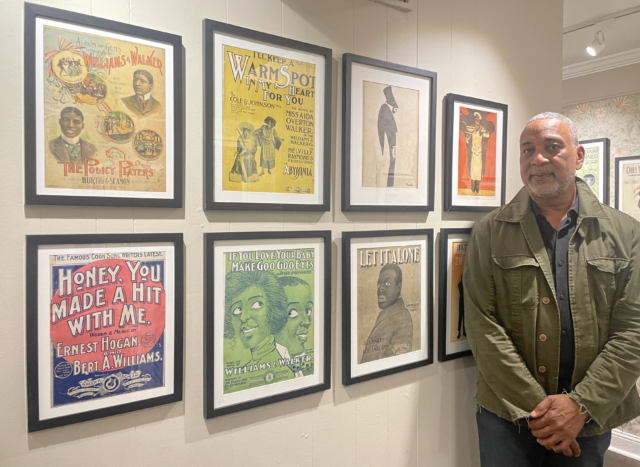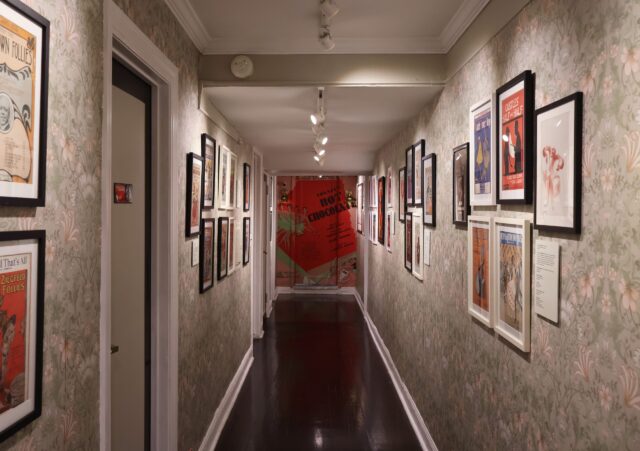
Curator and cultural historian John T. Reddick will give a talk on Tin Pan Alley on September 11 at the Society of Illustrators (photo by twi-ny/mdr)
ILLUSTRATING TIN PAN ALLEY: FROM RAGTIME TO JAZZ
Society of Illustrators
128 East Sixty-Third St. between Park & Lexington Aves.
Wednesday – Saturday through October 12, $10-$15
Tin Pan Alley Talk & Reception: Wednesday, September 11, $10-$15. 6:30
212-838-2560
societyillustrators.org
Longtime Harlem resident and Yale University School of Architecture graduate John T. Reddick is into bridge building — but in this case, the bridges aren’t physical structures but those that involve the lesser-known history of Tin Pan Alley. The birthplace of American popular music, Tin Pan Alley flourished in the late nineteenth and early twentieth centuries, when dozens of music publishers and businesses lined the streets of what is now Chelsea, in the West Twenties.
Born and raised in the integrated Philadelphia neighborhood of Mount Airy, Reddick got involved in trying to save Tin Pan Alley when five buildings on West Twenty-Eighth St. were in danger of being demolished by their owner/developer. In 2019, the Landmarks Preservation Commission designated them historic landmarks.
A founding member of Harlem Pride and the director of community engagement projects for the Central Park Conservancy, Reddick has been an avid collector of sheet music art, focusing on songs composed and/or performed by Black and Jewish entertainers. What began as a curiosity and hobby has blossomed into a dazzling exhibition at the Society of Illustrators, “Illustrating Tin Pan Alley: From Ragtime to Jazz,” on view through October 12.
“I felt like these artists were groundbreakers. I see in them many parallels to hip hop, in that ragtime’s innovation for its time was as jarring as hip hop’s,” he said of the composers and performers of the era during a tour of the show. “My journey began after I went to a talk on the Lower East Side given by Jeffery Gurock, who lectured on the period when Harlem was Jewish. That was a revelation to me, that Harlem had once been the second largest Jewish community in New York City. From that point I went to the library, did research, and started buying items on eBay. It was just shocking; as I bought sheet music or got to see the names, I realized they all lived in Harlem during the same time period.”
Arranged chronologically, the exhibit focuses on sheet music and its accompanying art, which reveals the developing connections between American Black and white music, beginning with the cakewalk, a Black dance that originated in America but became a craze when introduced in Europe, advancing its popularity as a hit in the United States. Several photographs and illustrations depict the cakewalk being performed, including two works by French artist Georges-Bertin Scott, sheet music covers for the songs “Darktown Is Out To-Night” and “Cake Walk Neath the Dixie Moon,” and a drawing in which Uncle Sam relaxes while watching dancers’ cakewalk around a tree.
On a nearby wall is the sheet music for “All Coons Look Alike to Me,” a popular 1898 song composed by Ernest Hogan that sold more than a million copies. Hogan, a prominent Black composer and performer, appeared in shows with the leading African American performers of the day. However, the song’s sheet music art, which featured unflattering caricatures of Black men and women, became such a crippling definer of Hogan as an artist that it led to his demise.
Reddick noted, “All of a sudden, this ragtime music is popular, and you want to show and sell us more. What do you use to image that music?” Reddick grouped together the sheet music covers for “Who Dat Say Chicken in Dis Crowd” by Paul Laurence Dunbar and Will Marion [Cook], “Cotton: A Southern Breakdown” by Albert Von Tilzer, and “Watermelon Am Good Enough for Mine” by G. Barker Richardson and Von Tilzer. “I have three things in there: cotton, chicken, and watermelon. They’re in the lyrics; they’re in the titles,” Reddick said. “A lot of the signifying, I feel, is coming out of music publishers just trying to meet the commercial market where its mind is at. You don’t cartoon something unless its understanding is pervasive. For me it’s the beginning of bridge building to some identity that’s beyond that becomes an American music.”
Other excellent groupings juxtapose two different sheet music covers for Lew Pollack’s “Vamping Sal the Sheba of Georgia” and three for Shelton Brooks’s “Darktown Strutters’ Ball.”
Pointing out that a lot of sheet music was dedicated to songwriter and journalist Monroe Rosenfeld because the performers knew he could talk them up in the newspaper, Reddick zeroed in on the team of Bert Williams and George Walker.
“Rosenfeld has this bridge relationship, so you see a lot of people pandering to him, even Williams and Walker, who coined themselves ‘the two real coons.’ They claimed the tag and the stage to establish their own authenticity and artistry. I realized in many ways it’s just like hip hop. You could have been the greatest hip-hop singer in the world, but if you went to amateur night at the Apollo and started singing in a tuxedo, you would be booed. You wouldn’t even get your mouth open because there’s a certain kind of drag they expect you to be in to perform. Williams and Walker knew they were good, but they realized that more whites were blacking-up and playing Blacks onstage than actual Black performers. It was so much more sophisticated. They could show that there’s parody and all this irony in lot of stuff they did.”
Every element, even the way the show is hung, carries some kind of weight. Reddick explained that for most of the works, a black frame indicates the song was written by a Black composer, a white frame by a white composer.
Perhaps not accidentally, the cover sheet for Jean Schwartz’s 1908 “The Whitewash Man,” depicting a smiling Black man carrying a paint bucket and a broom, is placed over a water fountain, evoking the “Whites Only” signs of the Jim Crow era.
Among the other composers and performers Reddick discussed were James Reese Europe and Ford T. Dabney, Noble Sissle and Eubie Blake, Irene and Vernon Castle, Irving Berlin, George Gershwin, Ethel Waters, Cab Calloway, Duke Ellington, Miss Aida Overton Walker, drummer Buddy Gilmore, Fats Waller, Sophie Tucker, Josephine Baker, and W. C. Handy as well as the Clef Club, the Ziegfeld Follies, the Cotton Club, Connie’s Inn, and Al Hirschfeld and Sydney Leff, two Jewish artists who attended the Vocational High School for the Arts on 138th Street in Harlem.
“Think of the names of Motown groups,” Reddick said. “The Supremes, the Marvelettes, the Temptations. Nobody’s a gangster. They’re claiming we deserve to be on the other side. Now we have a credential. . . . When the Central Park jogger case happened [in 1989], the term ‘wilding,’ it was just a term for young people being in nature and the park, not being there in the park to victimize people. But that was the first time it crossed over as a term from the Black community to the broader public. . . . So, I always think, what if bling had crossed over, associated with a jewelry store robbery as opposed to the fashions of hip-hop artists. Again, the word already had that meaning in my culture. Bling and jewelry. You got bling on, but at a certain point it crossed over, right? Maybe a hip-hop person, whatever. What was the bridge that made it happen?”

Tin Pan Alley exhibition winds down narrow hallway (photo courtesy of Society of Illustrators)
One of the most striking works is E. Simms Campbell’s gorgeously detailed 1932 “Night-Club-Map of Harlem,” which locates such hot spots as Smalls Paradise, Club Hot-Cha (“where nothing happens before 2 a.m.”), “the nice new police station,” Gladys’ Clam House, the Lafayette Theatre, the Radium Club, and the Savoy Ballroom, with cartoon vignettes of people dancing the lindy hop and the snakehips, men purchasing “marijuana cigarettes,” Bill “Bojangles” Robinson tapping away, and Tillie’s offering “specialties in fried chicken — and it’s really good.”
Reddick, who will give a lecture at the Society of Illustrators on September 11 at 6:30, followed by a reception with pianist/preservationist Adrian Untermyer, then told a story about American composer and violinist Will Marion Cook, who had studied with and influenced Antonín Dvořák’s take on America’s “Negro Music.”
“He performed and got a review that said he was one of the nation’s best colored violinists. And he took his violin to the critic and broke it and said, ‘I’m the best violinist.’ He wanted to start writing for Black shows and other Black players. He wrote with [poet and novelist] Paul Laurence Dunbar. But his family was so embarrassed for writing that ‘n—er’ music that in his first productions, he didn’t use his last name. However, Cook-associated shows such as 1898’s Clorindy and 1903’s In Dahomey served to bring a more diverse African American identity to the stage. What does that mean politically? If people are liking you, then they are seeing you in another light. What’s that going to mean on the political landscape?”
He added, “Now they could be voters. Picking cotton, you weren’t a voter. They’re playing at Madison Square Garden, so they’re at this elevated level. They’re having a life that was unimaginable for most Blacks.”
Above “All Coons Look Alike to Me” is a quote by W. E. B. Du Bois from his 1903 book The Souls of Black Folk: “It is a peculiar sensation, this double-consciousness, this sense of always looking at one’s self through the eyes of others . . . one ever feels his two-ness, an American, a Negro; two souls, two thoughts, two un-reconciled strivings.”
In “Illustrating Tin Pan Alley: From Ragtime to Jazz,” Reddick is reconciling those strivings and more, building bridges across race and class through a unique moment in New York City musical history.
[On September 19, the Society of Illustrators will host a happy hour from 5:00 to 9:00, with free admission, drink specials, and live music by Charlie Judkins, Miss Maybell, and Robert Lamont. Mark Rifkin is a Brooklyn-born, Manhattan-based writer and editor; you can follow him on Substack here.]